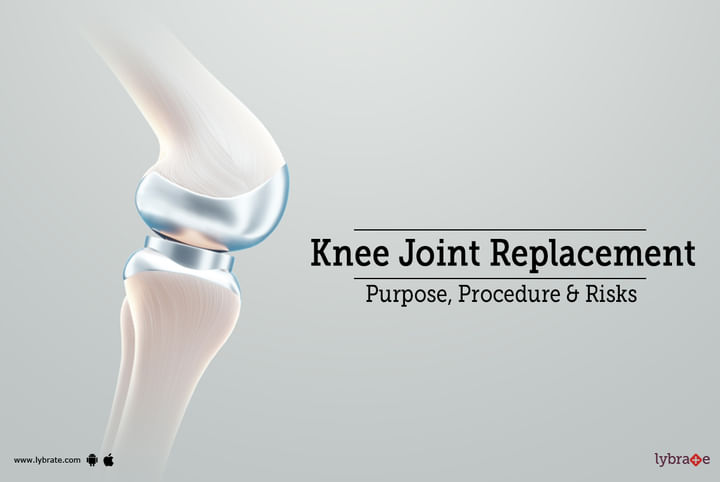Knee Joint Replacement: Purpose, Procedure & Risks
Knee joint replacement is a frequently performed surgical procedure by orthopedic surgeons, also referred to as knee arthroplasty. Total knee replacement surgery is a procedure that entails replacing a damaged or diseased knee joint with an artificial joint, or prosthesis, made of metal alloys, plastics, and polymers. The prosthesis is crafted to replicate the natural knee joint's functionality.
When considering knee replacement surgery, your doctor will take into account factors such as your age, weight, activity level, and overall health to help determine the best type of prosthesis for your individual needs.
During the surgery, your old knee joint will be removed and replaced with the prosthesis, which typically takes less than two hours. However, the recovery and rehabilitation process can take several months and will involve physical therapy and exercise to help regain strength and mobility in the knee.
What is the purpose of a knee joint replacement?
The primary purpose of knee joint replacement surgery is to relieve pain and improve mobility. Knee joint pain can be debilitating and severely impact an individual's quality of life, making it difficult to perform everyday tasks, such as walking, climbing stairs, or even getting out of bed. The primary benefits of knee joint replacement surgery include the relief of pain, improved mobility, and an overall enhancement in the quality of life for the patient.
The procedure is usually recommended for individuals who have tried other treatments, such as physical therapy, medication, and lifestyle changes, but have not experienced significant relief from knee pain or mobility issues.
Before recommending knee replacement surgery, doctors will typically explore less invasive treatment options to alleviate knee pain and improve mobility. Doctors may recommend less invasive treatments such as weight loss, medications, physical therapy, or assistive devices like a knee brace or cane as initial treatment options before recommending knee joint replacement surgery.
If these treatments fail to provide adequate relief, doctors may then consider knee replacement surgery. Factors that will be taken into account to determine if you are a good candidate for knee replacement include the extent to which knee pain affects your daily activities, such as walking or climbing stairs, whether your knee is deformed, bowed, or prone to instability, your age, and your overall health.
Ultimately, the decision to undergo knee replacement surgery should be a collaborative effort between you and your doctor, taking into account the risks, benefits, and potential outcomes of the procedure.
What is the procedure of a knee joint replacement?
The process of knee joint replacement surgery involves the removal of the damaged area of the knee joint, which may include cartilage and bone, and replacing it with an artificial joint made of materials such as metal, ceramic, or plastic. This new joint is specially designed to replicate the function of a natural knee joint, allowing for smooth movement and a wide range of motion.
Once the implantation of the artificial joint is complete, the surgeon will close the incision using either stitches or staples and apply a dressing to the knee. The entire procedure usually takes a few hours to complete, and patients are typically required to stay in the hospital for a few days to allow for observation and recovery.
Recovery
After knee joint replacement surgery, recovery time can vary from person to person and is dependent on factors such as age, overall health, and fitness level. Typically, patients will need to remain in the hospital for a few days following the procedure to monitor for any potential complications and start the recovery process. The total recovery period can take several weeks or even months.
During the recovery period, the patient will need to follow a rehabilitation program that includes physical therapy, exercise, and other activities designed to help strengthen the knee joint and improve mobility. The rehabilitation program is usually customized to meet the individual's specific needs and may involve working with a physical therapist, occupational therapist, or other healthcare professionals.
In the weeks and months following the surgery, the patient will need to avoid high-impact activities, such as running or jumping, and focus on low-impact activities, such as walking, swimming, or cycling. It is essential to follow the rehabilitation program carefully and avoid overexertion, as this can delay the recovery process and increase the risk of complications.
What happens after knee joint replacement?
After knee replacement surgery, it is normal to experience stiffness and pain in the affected leg. Your doctor will likely prescribe pain medication to help manage this discomfort, which may be administered intravenously. In some cases, you may receive long-acting local anesthetics or a nerve block during the surgery to help with postoperative pain. Additionally, medication to prevent blood clots may be given.
Most patients begin physical therapy on the day of or day after surgery to promote blood flow to the tissues around the new knee. Your surgeon may recommend the use of a continuous passive-motion machine, which is a special brace-like device that gently moves your knee in a bending motion.
Following your surgery, you will need to undergo a comprehensive physical therapy program tailored to your individual needs and capabilities. Your surgeon and physical therapy team will work together to develop a rehabilitation plan that is appropriate for your recovery.
What are the risks associated with knee joint replacement?
As with any surgical procedure, there are potential risks and complications associated with knee joint replacement surgery. Some of the most common risks include:
- Infection: Although the risk of infection is relatively low, it can still occur after knee joint replacement surgery. Symptoms of an infection may include redness, swelling, warmth, and pain around the knee joint.
- Blood clots: Blood clots can form in the legs after knee joint replacement surgery, which can be life-threatening if they travel to the lungs or other parts of the body.
- Nerve damage: Nerves near the knee joint can be damaged during the surgery, which can result in numbness, weakness, or tingling sensations in the leg.
- Implant failure: Knee joint implants can fail in some cases, which may require additional surgery to replace or repair the implant.
- Allergic reaction: In some cases, individuals may develop an allergic reaction to the materials used in the artificial joint during knee joint replacement surgery. This can cause symptoms like rash, hives, or difficulty breathing.
After surgery, some patients may encounter knee joint pain, stiffness, or a reduction in range of motion. In rare cases, the implant may become dislodged or wear down over time, requiring additional surgery to correct the issue.
To minimize the risk of complications, it is important for patients to carefully follow all pre- and post-operative instructions provided by their healthcare team. This may include avoiding certain medications or foods, following a specific exercise or rehabilitation program, and attending follow-up appointments with the surgeon or other healthcare professionals.
For people suffering from arthritis or other conditions causing severe knee pain and mobility problems, knee joint replacement surgery can be a highly effective treatment option. While the procedure does come with some risks and potential complications, most patients experience significant improvements in pain relief and mobility after surgery.
Before undergoing knee joint replacement surgery, it is crucial to have a thorough discussion with your healthcare provider about the procedure and carefully evaluate the potential risks and benefits. By working closely with your healthcare team and following all pre- and post-operative instructions, you can maximize the likelihood of a successful outcome and enjoy a more active, pain-free lifestyle.



+1.svg)
